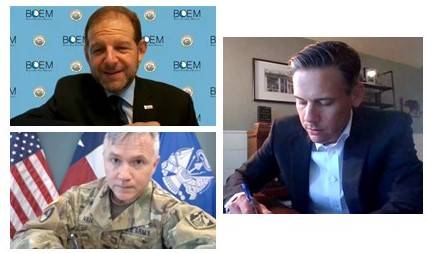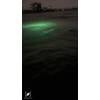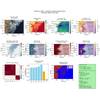Enhancing Understanding of Gulf Sediments

BOEM’s Gulf of Mexico Office Regional Director, Mike Celata, virtually signed a memorandum of understanding to address coastal restoration in Texas with Col. Timothy Vail, Commander, USACE Galveston District and Mark Havens, Deputy Land Commissioner for Texas GLO. This effort is intended to streamline and synchronize Gulf of Mexico sediment resource identification for Texas coastal protection and restoration projects and plans. (Courtesy USACE)
Galveston District of the U.S. Army Corps of Engineers has entered into a memorandum of understanding with the Bureau of Ocean Energy Management (BOEM) (a bureau of the U.S. Department of the Interior) and the Texas General Land Office (GLO) to streamline and synchronize Gulf of Mexico sediment resource identification data for use in Texas coastal protection and restoration plans and projects.
According to the memorandum, a framework will be developed to collect and share data and optimize engineering, economic, and environmental criteria by matching potential sediment sources with future restoration projects and post-construction re-nourishment requirements. The plan will provide each group with robust communication strategies and shared resources to evaluate alternatives to maximize utilization of offshore minerals for Coastal Storm Risk Management and Ecosystem Restoration (CSRM/ER) that can be applied anywhere in the United States.
"Working together with BOEM and GLO is key to our integrated plan for Texas coastal resilience,” said Col. Timothy Vail, Commander, USACE Galveston District. “Our agencies are working together to increase our understanding of existing data on sand resources, while at the same time identifying information gaps that we can work together to close. Each agency on this MOU has a significant role to play as we prepare for future large-scale restoration projects. Understanding the nature of coastal materials is critical to the success of those projects”
As the federal agency with jurisdiction over marine minerals on the Outer Continental Shelf, BOEM manages the use of non-energy marine minerals, including sediments, through environmentally responsible stewardship, prudent exploration and leasing activities, coordination with governmental partners and stakeholders, and mission-focused research to improve decision-making and management.
“By working together our agencies will be able to better serve the people of the Texas Gulf Coast through expediting the identification and distribution of significant sediment resources thus resulting in enhanced coastal resiliency and reduced risk to coastal assets,” said Mike Celata, BOEM’s Gulf of Mexico Office Regional Director.
USACE and GLO are partnered on several projects designed to increase the effectiveness of coastal features to protect people and land-based infrastructure from future storms – most notably, the comprehensive Coastal Texas Protection and Restoration Feasibility Study.
"The longevity of our beaches is crucial to the Texas coast," said Mark Havens, Deputy Land Commissioner for Texas GLO. "As erosion continues to diminish the size of our beaches, renourishment is essential to stabilize critical areas, protect private and public property, and provide added protection from the impacts of coastal storms and high tides. The Texas General Land Office is pleased to work alongside the Bureau of Ocean Management and the United States Army Corps of Engineers to protect and sustain the Texas coast through beach renourishment."













 December 2025
December 2025



